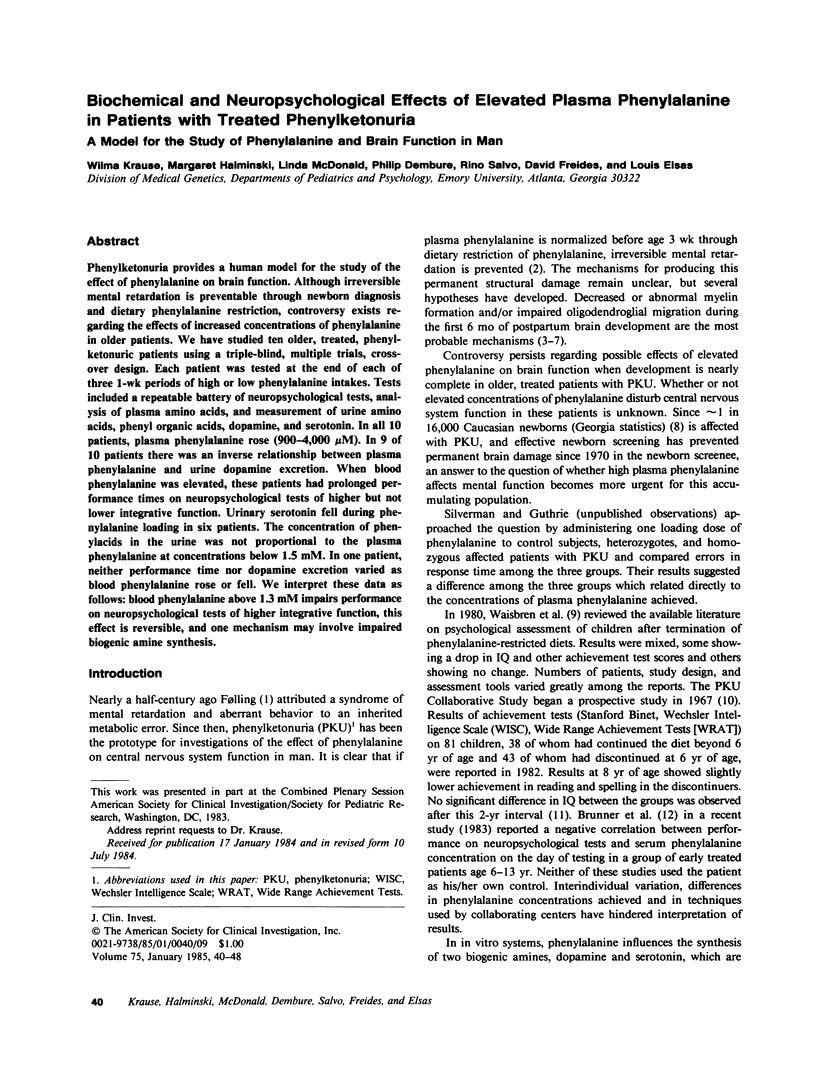Abstract
Phenylketonuria provides a human model for the study of the effect of phenylalanine on brain function. Although irreversible mental retardation is preventable through newborn diagnosis and dietary phenylalanine restriction, controversy exists regarding the effects of increased concentrations of phenylalanine in older patients. We have studied ten older, treated, phenylketonuric patients using a triple-blind, multiple trials, crossover design. Each patient was tested at the end of each of three 1-wk periods of high or low phenylalanine intakes. Tests included a repeatable battery of neuropsychological tests, analysis of plasma amino acids, and measurement of urine amino acids, phenyl organic acids, dopamine, and serotonin. In all 10 patients plasma phenylalanine rose (900-4,000 microM). In 9 of 10 patients there was an inverse relationship between plasma phenylalanine and urine dopamine excretion. When blood phenylalanine was elevated, these patients had prolonged performance times on neuropsychological tests of higher but not lower integrative function. Urinary serotonin fell during phenylalanine loading in six patients. The concentration of phenylacids in the urine was not proportional to the plasma phenylalanine at concentrations below 1.5 mM. In one patient, neither performance time nor dopamine excretion varied as blood phenylalanine rose or fell. We interpret these data as follows: blood phenylalanine above 1.3 mM impairs performance on neuropsychological tests of higher integrative function, this effect is reversible, and one mechanism may involve impaired biogenic amine synthesis.
Full text
PDF








Selected References
These references are in PubMed. This may not be the complete list of references from this article.
- Acosta P. B., Fernhoff P. M., Warshaw H. S., Elsas L. J., Hambidge K. M., Ernest A., McCabe E. R. Zinc status and growth of children undergoing treatment for phenylketonuria. J Inherit Metab Dis. 1982;5(2):107–110. doi: 10.1007/BF01800002. [DOI] [PubMed] [Google Scholar]
- Agrawal H. C., Bone A. H., Davison A. N. Effect of phenylalanine on protein synthesis in the developing rat brain. Biochem J. 1970 Apr;117(2):325–331. doi: 10.1042/bj1170325. [DOI] [PMC free article] [PubMed] [Google Scholar]
- BICKEL H., GERRARD J., HICKMANS E. M. The influence of phenylalanine intake on the chemistry and behaviour of a phenyl-ketonuric child. Acta Paediatr. 1954 Jan;43(1):64–77. doi: 10.1111/j.1651-2227.1954.tb04000.x. [DOI] [PubMed] [Google Scholar]
- Brunner R. L., Jordan M. K., Berry H. K. Early-treated phenylketonuria: neuropsychologic consequences. J Pediatr. 1983 Jun;102(6):831–835. doi: 10.1016/s0022-3476(83)80007-9. [DOI] [PubMed] [Google Scholar]
- Curtius H. C., Niederwieser A., Viscontini M., Leimbacher W., Wegmann H., Blehova B., Rey F., Schaub J., Schmidt H. Serotonin and dopamine synthesis in phenylketonuria. Adv Exp Med Biol. 1981;133:277–291. doi: 10.1007/978-1-4684-3860-4_16. [DOI] [PubMed] [Google Scholar]
- Ikeda M., Levitt M., Udenfriend S. Phenylalanine as substrate and inhibitor of tyrosine hydroxylase. Arch Biochem Biophys. 1967 May;120(2):420–427. doi: 10.1016/0003-9861(67)90259-7. [DOI] [PubMed] [Google Scholar]
- Johnson R. C., Shah S. N. Effects of alpha-methylphenylalanine plus phenylalanine treatment during development on myelin in rat brain. Neurochem Res. 1980 Jul;5(7):709–718. doi: 10.1007/BF00964709. [DOI] [PubMed] [Google Scholar]
- Katz I., Lloyd T., Kaufman S. Studies on phenylalanine and tyrosine hydroxylation by rat brain tyrosine hydroxylase. Biochim Biophys Acta. 1976 Oct 11;445(3):567–578. doi: 10.1016/0005-2744(76)90111-x. [DOI] [PubMed] [Google Scholar]
- Koch R., Azen C. G., Friedman E. G., Williamson M. L. Preliminary report on the effects of diet discontinuation in PKU. J Pediatr. 1982 Jun;100(6):870–875. doi: 10.1016/s0022-3476(82)80503-9. [DOI] [PubMed] [Google Scholar]
- Lines D. R., Waisman H. A. Urinary amino acid excretion in phenylketonuric, hyperphenylalaninemic, and normal patients. J Pediatr. 1971 Mar;78(3):474–480. doi: 10.1016/s0022-3476(71)80230-5. [DOI] [PubMed] [Google Scholar]
- McGeer E. G., McGeer P. L., Wada J. A. Distribution of tyrosine hydroxylase in human and animal brain. J Neurochem. 1971 Sep;18(9):1647–1658. doi: 10.1111/j.1471-4159.1971.tb03738.x. [DOI] [PubMed] [Google Scholar]
- McKean C. M. The effects of high phenylalanine concentrations on serotonin and catecholamine metabolism in the human brain. Brain Res. 1972 Dec 12;47(2):469–476. doi: 10.1016/0006-8993(72)90653-1. [DOI] [PubMed] [Google Scholar]
- NADLER H. L., HSIA D. Y. Epinephrine metabolism in phenylketonuria. Proc Soc Exp Biol Med. 1961 Aug-Sep;107:721–723. doi: 10.3181/00379727-107-26734. [DOI] [PubMed] [Google Scholar]
- Oldendorf W. H. Saturation of blood brain barrier transport of amino acids in phenylketonuria. Arch Neurol. 1973 Jan;28(1):45–48. doi: 10.1001/archneur.1973.00490190063008. [DOI] [PubMed] [Google Scholar]
- Pardridge W. M., Oldendorf W. H. Kinetic analysis of blood-brain barrier transport of amino acids. Biochim Biophys Acta. 1975 Aug 5;401(1):128–136. doi: 10.1016/0005-2736(75)90347-8. [DOI] [PubMed] [Google Scholar]
- Peskar B., Spector S. Serotonin: radioimmunoassay. Science. 1973 Mar 30;179(4080):1340–1341. doi: 10.1126/science.179.4080.1340. [DOI] [PubMed] [Google Scholar]
- Peuler J. D., Johnson G. A. Simultaneous single isotope radioenzymatic assay of plasma norepinephrine, epinephrine and dopamine. Life Sci. 1977 Sep 1;21(5):625–636. doi: 10.1016/0024-3205(77)90070-4. [DOI] [PubMed] [Google Scholar]
- Shah S. N., Peterson N. A., McKean C. M. Lipid composition of human cerebral white matter and myelin in phenylketonuria. J Neurochem. 1972 Oct;19(10):2369–2376. doi: 10.1111/j.1471-4159.1972.tb01291.x. [DOI] [PubMed] [Google Scholar]
- Van Loon G. R., Sole M. J. Plasma dopamine: source, regulation, and significance. Metabolism. 1980 Nov;29(11 Suppl 1):1119–1123. doi: 10.1016/0026-0495(80)90020-7. [DOI] [PubMed] [Google Scholar]
- WEIL-MALHERBE H. The concentration of adrenaline in human plasma and its relation to mental activity. J Ment Sci. 1955 Oct;101(425):733–755. doi: 10.1192/bjp.101.425.733. [DOI] [PubMed] [Google Scholar]
- Waisbren S. E., Schnell R. R., Levy H. L. Diet termination in children with phenylketonuria: a review of psychological assessments used to determine outcome. J Inherit Metab Dis. 1980;3(4):149–153. doi: 10.1007/BF02312549. [DOI] [PubMed] [Google Scholar]
- Williamson M., Dobson J. C., Koch R. Collaborative study of children treated for phenylketonuria: study design. Pediatrics. 1977 Dec;60(6):815–821. [PubMed] [Google Scholar]


